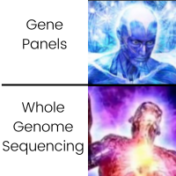Modern genomics workflows often require multiple specialized tools working in concert. In the upcoming VarSeq release, we are excited to announce the option for tighter integration with IGV. Genomics researchers and clinicians are well-versed in using IGV as a visualization tool for their genomic data. This new option will allow for synchronizing the view in the Golden Helix GenomeBrowser with… Read more »
Pharmacogenomic (PGx) analysis empowers researchers and clinicians to tailor drug therapies based on a patient’s genetic profile, but not all regions of the genome are easy to interpret. Genes like CYP2D6 and HLA-A are tricky when it comes to rendering diplotype calls. This is due to a number of factors including high polymorphism, structural variations (including copy number variants), and… Read more »
The VarSeq platform has been on the market for over a decade and has established itself as robust and powerful clinical-grade bioinformatics software. Its usage spans many types of analysis, including pharmacogenomics, rare disease, hereditary cancer, somatic, carrier risk, and trio/family. Fundamentally, users have the freedom to build any workflow they need, which is a significant value proposition compared to… Read more »
Creating and managing sample manifest files in VarSeq has traditionally been a time-consuming process that demands precision and attention to detail. The upcoming VSWarehouse 3 release will feature the ability to use catalogs to save and load sample fields in VarSeq projects. Not only will this allow for easy population of sample fields in VarSeq, but it also has the… Read more »
Golden Helix field application scientists curate a set of FAS templates that capture best practices for filtering, which we use when training and onboarding customers. In addition to the basic templates that come default with the software, these more fleshed-out templates are available upon request. This first blog in the series focuses on germline variant analysis. Rare Pathogenic Variants The… Read more »
In a recent blog post, we explored how phased genotypes provide crucial insights by separating variants into distinct haplotypes—groups of alleles inherited together from a single parent. We also discussed how the combined impact of multiple variants within the same gene can significantly differ from their individual effects. However, accurately assessing the joint impact of these in-phase variants is a… Read more »
Our customers asked for a step-by-step tutorial for navigating a pharmacogenomic (PGx) workflow in VarSeq, and we are happy to have it delivered! Our brand new PGx tutorial can be found on our website, along with our other VarSeq tutorials. Like our other famous tutorials, this one will provide example data, or you may follow along with your own star… Read more »
In the last year, we have seen a surge in customers moving to whole genome sequencing. Not only does whole genome sequencing provide unparalleled gene coverage compared to whole exome, but depending on the kind of sequencing, you may expect to see additional file types as well. For example, our partners at PacBio will provide an additional VCF containing copy… Read more »
We are pleased to announce new training materials are available for multi-sample workflows in VarSeq! Specifically, we have a New Carrier Screening Tutorial and New Onboarding and Training guides for Carrier Screening Analysis in VarSeq, and Clinical Evaluation and Carrier Status Reporting in VSClinical. This blog gives an overview of what the user can expect to encounter when working through… Read more »
The latest VarSeq release offers enhanced control over genome browse visualization computations. These computations, which are responsible for computing and caching coverage files that create the aggregate view of tracks within GenomeBrowse, are now more flexible. Typically, these tracks create files with the “.covtsf” extension and are used for zoomed-out density views of sources like VCFs and BAMs. Managing Automatic… Read more »
Recently, we have written a couple of blogs that were talking about the use of Evaluation Scripts in VSClinical workflows, in particular for the AMP workflow. Evaluation scripts were first introduced to VSClinical AMP in VarSeq 2.3.0 and VarSeq 2.4.0 welcomed evaluation scripts to the ACMG Workflow. Evaluation scripts are a nifty way to customize your workflow and say import… Read more »
Variant interpretation is a critical aspect of any clinical NGS workflow. VarSeq assessment catalogs are a tool used to save variants and associated variant information for easy tracking and retrieval of completed variant interpretations. As variant interpretations stack up and classifications are saved, storing in assessment catalogs makes it easy to automatically fill in a previous interpretation if the variant… Read more »
In recent weeks, GenomeBrowse capabilities have had a sudden resurgence of interest among our customers. To support this, the FAS team wanted to share with you several under-utilized GenomeBrowse plotting tricks. First, let’s cover plotting a BED file for easy track viewing. The first step is launching a GenomeBrowse window by clicking the + button and selecting GenomeBrowse (Figure 1)…. Read more »
Explore the evolving landscape of genomic analysis, transitioning from targeted gene panels to whole genome sequencing. A recent trend with our customers has been to expand their workflows from small panel sequencing analyses to larger whole exome and genome sequencing analyses. The decreasing cost of sequencing has made this a rather common request. Although more data allows for a greater… Read more »
Use the force of evaluation scripts to automate and customize your VSClinical ACMG workflow in VarSeq 2.4.0. VarSeq 2.3.0 came packed with new features! Most notably, VarSeq variant analysis expanded to support the import and annotation of structural variant files, and the AMP cancer workflow in VSClinical gained new functionality with the addition of evaluation scripts which help automate and… Read more »
Unlock the potential of VarSeq for efficient analysis of structural variants, providing robust annotation, filtering, and interpretation of intricate genetic variations. While the analysis of structural variants (SVs) is crucial for understanding the genetic basis of disease, the process of interpreting these variations can be a challenging and complex task. Structural variant callers typically store rearrangements in VCF files, which… Read more »
Discover how soft clip visualization can help you identify structural variants in your research and improve the accuracy of your findings. Soft clipping is a common technique in sequence alignment used to remove bases from the ends of reads that do not align with the reference sequence. Removing these bases typically improves alignment accuracy. However, when multiple reads are soft… Read more »
Unlocking the intricacies of fusion representations is crucial for understanding the impact of complex genetic rearrangements on gene function and disease development. In the most recent release of VarSeq, we added support for the import of complex rearrangements from VCF files, which typically encode rearrangements using breakend notation. This powerful notation is capable of describing the full spectrum of structural… Read more »
Our FAS team has received a flurry of inquiries recently, asking how to run coverage statistics on their projects without a pre-defined BED file. We’re here to help! To analyze sample coverage statistics, you’ll need a BAM or CRAM file that displays the read depth coverage for your samples. But don’t worry, even if you don’t have a BED file,… Read more »
Revolutionize Your Somatic Variant Analysis with Our Cutting-Edge Template for Annotation and Filtering in VarSeq Golden Helix is excited to share our new Comprehensive Cancer Template for somatic variant annotation and filtering, along with the latest version of our software VarSeq 2.3.0! Our latest VarSeq update was specifically focused on getting up to speed with multiple aspects of somatic variant… Read more »














